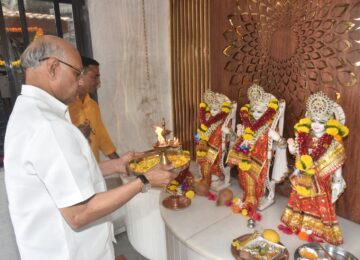Anupama Nair
Ayurveda is one of the world's oldest holistic i.e., ‘whole-body’ healing systems and it was developed more than 3,000 years ago in India. It’s based on the belief that health and wellness depend on a proper balance between the mind, body, and spirit. Its main goal is to promote good health, and just not fight disease. However, treatments may be geared toward specific health problems. It is believed that everything in the universe, dead or alive is connected. If your mind, body, and spirit are in harmony with the universe, you have good health. When something disrupts this balance, you get sick. Among the things that can upset the balance are genetic or birth defects, injuries, climate and seasonal change, age, and your emotions.
Those who practice Ayurveda believe that every person is made of five basic elements found in the universe — sky, air, fire, water, and earth. An Ayurvedic practitioner will create a treatment plan specifically designed for you. They’ll take into account your unique physical and emotional makeup, your primary life force, and the balance between all three of these elements and the goal of the treatment is to cleanse your body of undigested food, which can stay in your body and cause illness. The cleansing process called ‘panchakarma’ is designed to reduce your symptoms and restore harmony and balance. To achieve this, an Ayurvedic practitioner might rely on blood purification, massage, medical oils, herbs, and enemas or laxatives.
What is diabetes? Diabetes is often called as the ‘silent killer’ and a person with diabetes knows the pain when he sees his friends enjoying themselves and realizes his life devoid of sweetness. In layman terms if you have diabetes, your body cannot properly process and use glucose from the food you eat. There are different types of diabetes, each with different causes, but they all share the common problem of having too much glucose in your bloodstream. Treatments include medications and/or insulins. Some types of diabetes can be prevented by adopting a healthy lifestyle.
Poorly controlled diabetes can lead to serious consequences, causing damage to a wide range of your body's organs and tissues – including your heart, kidneys, eyes and nerves. The process of digestion includes breaking down the food you eat into various different nutrients. When you eat carbohydrates like bread, rice, pasta or chapatis, your body breaks this down into sugar or glucose. When glucose is in your bloodstream, it needs help or ‘key’ called insulin to get into its final destination where it's used, which is inside your body's cells
Insulin is a hormone made by your pancreas, an organ located behind your stomach. The pancreas releases insulin into your bloodstream and insulin acts as the ‘key which unlocks the door of the cell wall that allows glucose to enter your body’s cells. Glucose is the ‘fuel’ or energy, tissues and organs need to function properly.
When you suffer from diabetes, your pancreas either doesn’t make any insulin or enough insulin or your pancreas makes insulin but your body’s cells don’t respond to it and can’t use it as it normally does. If glucose can’t get into your body’s cells, it stays in your bloodstream and your blood glucose level rises. Diabetes can be reversed or at least reduced by making some lifestyle changes, modifying eating habits and becoming physically active.
Diabetes is called as Madhumeha in Ayurveda, and is considered one of the 20 types of Prameha or urological disorders. Madhu means sweet and meha means urine in Sanskrit which in layman terms translates to 'urine that smells sweet'. One doesn't get diagnosed with diabetes mellitus all of a sudden. There are warning signs and symptoms that indicate trouble. If you feel excessively thirsty, fatigue, frequent urination, unintended weight loss, increased hunger, numbness or tingling in the feet or hands, you may be suffering from prediabetes. The difference between diabetes and prediabetes is that in the latter you do not need medication to manage blood glucose levels.
People diagnosed with prediabetes have a high risk of developing full-blown type 2 diabetes and suffering from its many complications. However, prediabetes is also the disease that can be reversed by modifying eating habits and becoming physically active. Some simple tips can go a long way in keeping this killer disease at bay. The tips are:
- Avoid white sugar, and switch to natural sugars
- Exercise for an hour
- Start consuming Nisha amlaki
- Have early dinner
- Have sound sleep
What is Nisha Amlaki, you might ask? You can make it at home — take equal quantity of amla powder and turmeric and mix them together. You need to take 2 gm of Nisha Amalki daily in morning on empty stomach with warm water.
What we need to understand is any disease can be controlled with proper care.




























